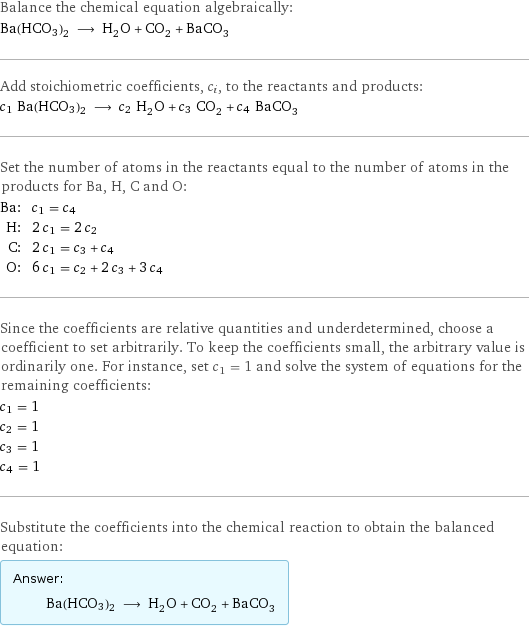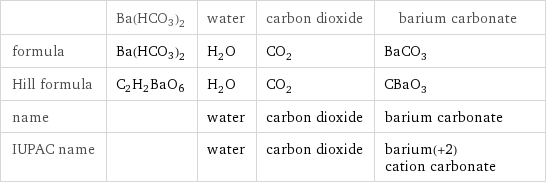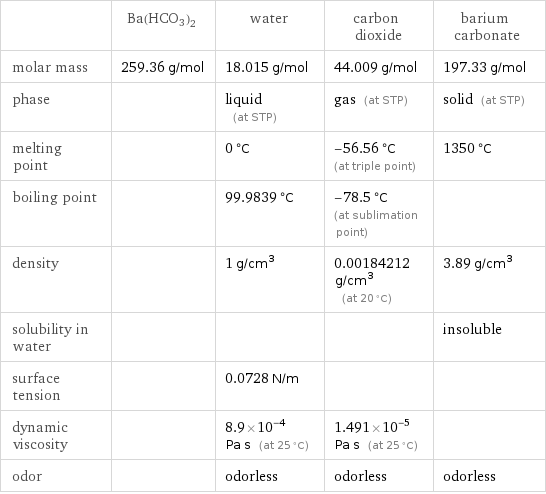Input interpretation

Ba(HCO3)2 ⟶ H_2O water + CO_2 carbon dioxide + BaCO_3 barium carbonate
Balanced equation

Balance the chemical equation algebraically: Ba(HCO3)2 ⟶ H_2O + CO_2 + BaCO_3 Add stoichiometric coefficients, c_i, to the reactants and products: c_1 Ba(HCO3)2 ⟶ c_2 H_2O + c_3 CO_2 + c_4 BaCO_3 Set the number of atoms in the reactants equal to the number of atoms in the products for Ba, H, C and O: Ba: | c_1 = c_4 H: | 2 c_1 = 2 c_2 C: | 2 c_1 = c_3 + c_4 O: | 6 c_1 = c_2 + 2 c_3 + 3 c_4 Since the coefficients are relative quantities and underdetermined, choose a coefficient to set arbitrarily. To keep the coefficients small, the arbitrary value is ordinarily one. For instance, set c_1 = 1 and solve the system of equations for the remaining coefficients: c_1 = 1 c_2 = 1 c_3 = 1 c_4 = 1 Substitute the coefficients into the chemical reaction to obtain the balanced equation: Answer: | | Ba(HCO3)2 ⟶ H_2O + CO_2 + BaCO_3
Structures

Ba(HCO3)2 ⟶ + +
Names

Ba(HCO3)2 ⟶ water + carbon dioxide + barium carbonate
Equilibrium constant
![Construct the equilibrium constant, K, expression for: Ba(HCO3)2 ⟶ H_2O + CO_2 + BaCO_3 Plan: • Balance the chemical equation. • Determine the stoichiometric numbers. • Assemble the activity expression for each chemical species. • Use the activity expressions to build the equilibrium constant expression. Write the balanced chemical equation: Ba(HCO3)2 ⟶ H_2O + CO_2 + BaCO_3 Assign stoichiometric numbers, ν_i, using the stoichiometric coefficients, c_i, from the balanced chemical equation in the following manner: ν_i = -c_i for reactants and ν_i = c_i for products: chemical species | c_i | ν_i Ba(HCO3)2 | 1 | -1 H_2O | 1 | 1 CO_2 | 1 | 1 BaCO_3 | 1 | 1 Assemble the activity expressions accounting for the state of matter and ν_i: chemical species | c_i | ν_i | activity expression Ba(HCO3)2 | 1 | -1 | ([Ba(HCO3)2])^(-1) H_2O | 1 | 1 | [H2O] CO_2 | 1 | 1 | [CO2] BaCO_3 | 1 | 1 | [BaCO3] The equilibrium constant symbol in the concentration basis is: K_c Mulitply the activity expressions to arrive at the K_c expression: Answer: | | K_c = ([Ba(HCO3)2])^(-1) [H2O] [CO2] [BaCO3] = ([H2O] [CO2] [BaCO3])/([Ba(HCO3)2])](../image_source/d5c6e3d9f64e29e9c5767a8a695bfcb0.png)
Construct the equilibrium constant, K, expression for: Ba(HCO3)2 ⟶ H_2O + CO_2 + BaCO_3 Plan: • Balance the chemical equation. • Determine the stoichiometric numbers. • Assemble the activity expression for each chemical species. • Use the activity expressions to build the equilibrium constant expression. Write the balanced chemical equation: Ba(HCO3)2 ⟶ H_2O + CO_2 + BaCO_3 Assign stoichiometric numbers, ν_i, using the stoichiometric coefficients, c_i, from the balanced chemical equation in the following manner: ν_i = -c_i for reactants and ν_i = c_i for products: chemical species | c_i | ν_i Ba(HCO3)2 | 1 | -1 H_2O | 1 | 1 CO_2 | 1 | 1 BaCO_3 | 1 | 1 Assemble the activity expressions accounting for the state of matter and ν_i: chemical species | c_i | ν_i | activity expression Ba(HCO3)2 | 1 | -1 | ([Ba(HCO3)2])^(-1) H_2O | 1 | 1 | [H2O] CO_2 | 1 | 1 | [CO2] BaCO_3 | 1 | 1 | [BaCO3] The equilibrium constant symbol in the concentration basis is: K_c Mulitply the activity expressions to arrive at the K_c expression: Answer: | | K_c = ([Ba(HCO3)2])^(-1) [H2O] [CO2] [BaCO3] = ([H2O] [CO2] [BaCO3])/([Ba(HCO3)2])
Rate of reaction
![Construct the rate of reaction expression for: Ba(HCO3)2 ⟶ H_2O + CO_2 + BaCO_3 Plan: • Balance the chemical equation. • Determine the stoichiometric numbers. • Assemble the rate term for each chemical species. • Write the rate of reaction expression. Write the balanced chemical equation: Ba(HCO3)2 ⟶ H_2O + CO_2 + BaCO_3 Assign stoichiometric numbers, ν_i, using the stoichiometric coefficients, c_i, from the balanced chemical equation in the following manner: ν_i = -c_i for reactants and ν_i = c_i for products: chemical species | c_i | ν_i Ba(HCO3)2 | 1 | -1 H_2O | 1 | 1 CO_2 | 1 | 1 BaCO_3 | 1 | 1 The rate term for each chemical species, B_i, is 1/ν_i(Δ[B_i])/(Δt) where [B_i] is the amount concentration and t is time: chemical species | c_i | ν_i | rate term Ba(HCO3)2 | 1 | -1 | -(Δ[Ba(HCO3)2])/(Δt) H_2O | 1 | 1 | (Δ[H2O])/(Δt) CO_2 | 1 | 1 | (Δ[CO2])/(Δt) BaCO_3 | 1 | 1 | (Δ[BaCO3])/(Δt) (for infinitesimal rate of change, replace Δ with d) Set the rate terms equal to each other to arrive at the rate expression: Answer: | | rate = -(Δ[Ba(HCO3)2])/(Δt) = (Δ[H2O])/(Δt) = (Δ[CO2])/(Δt) = (Δ[BaCO3])/(Δt) (assuming constant volume and no accumulation of intermediates or side products)](../image_source/77d23a6511976313fb6cb13249f7798f.png)
Construct the rate of reaction expression for: Ba(HCO3)2 ⟶ H_2O + CO_2 + BaCO_3 Plan: • Balance the chemical equation. • Determine the stoichiometric numbers. • Assemble the rate term for each chemical species. • Write the rate of reaction expression. Write the balanced chemical equation: Ba(HCO3)2 ⟶ H_2O + CO_2 + BaCO_3 Assign stoichiometric numbers, ν_i, using the stoichiometric coefficients, c_i, from the balanced chemical equation in the following manner: ν_i = -c_i for reactants and ν_i = c_i for products: chemical species | c_i | ν_i Ba(HCO3)2 | 1 | -1 H_2O | 1 | 1 CO_2 | 1 | 1 BaCO_3 | 1 | 1 The rate term for each chemical species, B_i, is 1/ν_i(Δ[B_i])/(Δt) where [B_i] is the amount concentration and t is time: chemical species | c_i | ν_i | rate term Ba(HCO3)2 | 1 | -1 | -(Δ[Ba(HCO3)2])/(Δt) H_2O | 1 | 1 | (Δ[H2O])/(Δt) CO_2 | 1 | 1 | (Δ[CO2])/(Δt) BaCO_3 | 1 | 1 | (Δ[BaCO3])/(Δt) (for infinitesimal rate of change, replace Δ with d) Set the rate terms equal to each other to arrive at the rate expression: Answer: | | rate = -(Δ[Ba(HCO3)2])/(Δt) = (Δ[H2O])/(Δt) = (Δ[CO2])/(Δt) = (Δ[BaCO3])/(Δt) (assuming constant volume and no accumulation of intermediates or side products)
Chemical names and formulas

| Ba(HCO3)2 | water | carbon dioxide | barium carbonate formula | Ba(HCO3)2 | H_2O | CO_2 | BaCO_3 Hill formula | C2H2BaO6 | H_2O | CO_2 | CBaO_3 name | | water | carbon dioxide | barium carbonate IUPAC name | | water | carbon dioxide | barium(+2) cation carbonate
Substance properties

| Ba(HCO3)2 | water | carbon dioxide | barium carbonate molar mass | 259.36 g/mol | 18.015 g/mol | 44.009 g/mol | 197.33 g/mol phase | | liquid (at STP) | gas (at STP) | solid (at STP) melting point | | 0 °C | -56.56 °C (at triple point) | 1350 °C boiling point | | 99.9839 °C | -78.5 °C (at sublimation point) | density | | 1 g/cm^3 | 0.00184212 g/cm^3 (at 20 °C) | 3.89 g/cm^3 solubility in water | | | | insoluble surface tension | | 0.0728 N/m | | dynamic viscosity | | 8.9×10^-4 Pa s (at 25 °C) | 1.491×10^-5 Pa s (at 25 °C) | odor | | odorless | odorless | odorless
Units
